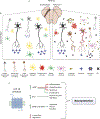Glucagon-like peptide-1 (GLP-1)-based receptor agonists as a treatment for Parkinson's disease
- PMID: 32412796
- PMCID: PMC10477949
- DOI: 10.1080/13543784.2020.1764534
Glucagon-like peptide-1 (GLP-1)-based receptor agonists as a treatment for Parkinson's disease
Abstract
Introduction: Accumulating evidence supports the evaluation of glucagon-like peptide-1 (GLP-1) receptor (R) agonists for the treatment of the underlying pathology causing Parkinson's Disease (PD). Not only are these effects evident in models of PD and other neurodegenerative disorders but recently in a randomized, double-blind, placebo-controlled clinical trial, a GLP-1R agonist has provided improved cognition motor functions in humans with moderate PD.
Areas covered: In this mini-review, we describe the development of GLP-1R agonists and their potential therapeutic value in treating PD. Many GLP-1R agonists are FDA approved for the treatment of metabolic disorders, and hence can be rapidly repositioned for PD. Furthermore, we present preclinical data offering insights into the use of monomeric dual- and tri-agonist incretin-based mimetics for neurodegenerative disorders. These drugs combine active regions of GLP-1 with those of glucose-dependent insulinotropic peptide (GIP) and/or glucagon (Gcg).
Expert opinion: GLP-1Ragonists offer a complementary and enhanced therapeutic value to other drugs used to treat PD. Moreover, the use of the dual- or tri-agonist GLP-1-based mimetics may provide combinatory effects that are even more powerful than GLP-1R agonism alone. We advocate for further investigations into the repurposing of GLP-1R agonists and the development of classes of multi-agonists for PD treatment.
Keywords: Glucagon-like peptide-1 (GLP-1); Parkinson’s disease; brain trauma; glucagon (Gcg); glucose-dependent insulinotropic peptide (GIP); incretin mimetics; microglia; neurodegeneration.
Figures



References
-
- Drucker DJ. Mechanisms of action and therapeutic application of glucagon-like peptide-1. Cell Metab. 2018;27:740–756. - PubMed
-
-
Eng J, Kleinman WA, Singh L, et al. Isolation and characterization of exendin-4, an exendin-3 analogue, from Heloderma suspectum venom: further evidence for an exendin receptor on dispersed acini from guinea pig pancreas. J Biol Chem. 1992;267:7402–7405.
•• This publication outlines the discovery of Exendin-4, a DPP-IV-resistant analog of human GLP-1. This discovery led to the new class of long-acting T2DM drugs and is the foundation for the structures of emerging multiagonists.
-
-
-
Glotfelty EJ, Delgado TE, Tovar-y-Romo LB, et al. Incretin mimetics as rational candidates for the treatment of traumatic brain injury. ACS Pharmacol. Transl. Sci. 2019;2:66–91.
• This is a recent comprehensive review that outlines much of the research and use of incretin mimetics for neurodegenerative disorders. It covers major signalling mechanisms common among these disorders.
-
Publication types
MeSH terms
Substances
Grants and funding
LinkOut - more resources
Full Text Sources
Medical
